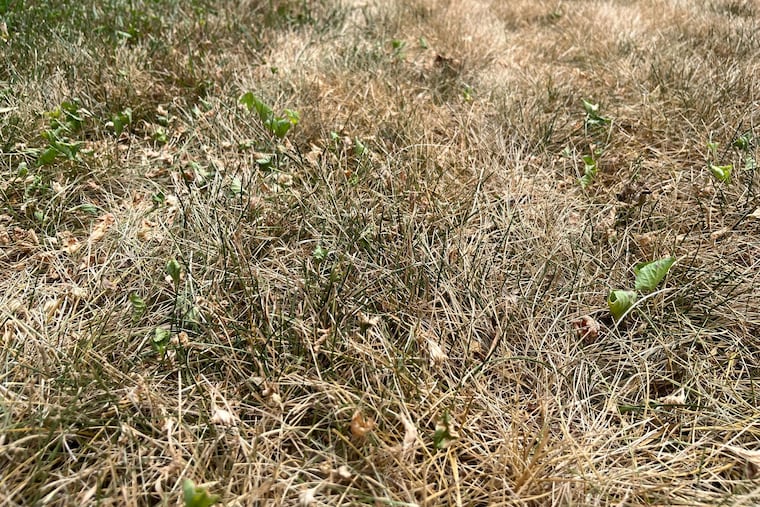Backyard fire pit, campfires banned in N.J. as ‘some of the driest conditions ever’ spread across state
Officials say the next few days are of extra concern because winds are expected to gust 20 mph or more with very low humidity. No rain is in the forecast.

With fire danger at an “extreme,” New Jersey officials have enacted a statewide mandatory ban on wood and charcoal fires, whether on public or private property.
“We are currently experiencing some of the driest conditions ever, making our forests, in particular the sprawling Pinelands region of southern New Jersey, especially vulnerable to wildfires that could spread very quickly and threaten property,” New Jersey Department of Environmental Commissioner Shawn LaTourette said in a statement this week. “It is critical that members of the public be extra cautious about fire prevention and refrain from using any open flames.”
The ban, enacted Monday, prohibits fires unless they are in an elevated stove that uses propane, natural gas, or electricity. Wood and charcoal fires are prohibited, as are kerosene and gas torches. The ban is in place for all 564 municipalities.
That means campers at the state’s parks must do without fires.
What are current conditions?
Officials say the next few days are of extra concern because winds are expected to gust 20 mph or more with very low humidity. No rain is in the forecast for at least the next week, and most days are expected to be sunny.
“When conditions become this dry, the simplest things can start a wildfire,” said Bill Donnelly, chief of the state Forest Fire Service. “In my 30-year career with the Forest Fire Service, I can’t recall a time when we faced such a prolonged period of dry weather with no relief in sight.”
Larry Hajna, a spokesperson for the New Jersey Department of Environmental Protection, said that the current fire restrictions “are not common.”
John Cecil, assistant commissioner for State Parks, Forests & Historic Sites, said that similar weather conditions in the late 1800s prompted the state to create the Forest Fire Service.
Gov. Phil Murphy declared a statewide drought watch last week and urged residents and businesses to voluntarily conserve water. The goal of the watch is make the public aware of the dry conditions and that water levels in streams, reservoirs, and groundwater are low. Groundwater is found underground in aquifers, which are cracks in spaces of soil, sand, and rock that collect and store water. If conditions don’t improve, the state could declare a drought warning or drought emergency, possibly leading to mandatory restrictions.
Southern New Jersey has fared worse than the rest of the state. Many areas are running 6.4 to 7.6 inches below normal for rainfall over the past 90 days.
The drought index, used by the state Forest Fire Service, is at 725, which is near the top level of 800. The index, which gauges forest fire potential, takes into account the dryness of soil, as well as that of leaves, pine needles, branches, and twigs on the forest floor. State officials said in a statement that the current level is “near top level drought conditions and a condition rarely observed over decades of observations.”
They are asking people not to toss cigarettes, matches, or smoking materials on the ground and to use indoor wood stoves and fireplaces carefully.
How about Pennsylvania?
So far, Pennsylvania officials have not made any drought declarations nor related restrictions. However, the U.S. Drought Monitor map, produced by the National Drought Mitigation Center at the University of Nebraska-Lincoln, the National Oceanic and Atmospheric Administration, and U.S. Department of Agriculture, shows much of the southeastern part of the state is experiencing severe drought conditions.
The state’s Department of Environmental Protection uses various indicators including stream flow, groundwater level, precipitation, and soil moisture. The DEP would make a drought declaration only after monitoring departures from normal ranges over a period of 3 to 12 months. It also considers information from public water suppliers.
Regardless of any declaration, the National Weather Service issued a statement that there is an increased risk of fire for the region, including Philadelphia, given the low humidity and wind gusts.
“These conditions will support the spread of any fires that ignite, which could quickly become difficult to control,” the statement said. “Outdoor burning is strongly discouraged.”
Keeping an eye on the salt line
Kate Schmidt, a spokesperson for the Delaware River Basin Commission (DRBC), a multistate agency that manages water use in the Delaware River, said officials are watching conditions closely.
The DRBC said it is unusually dry throughout the Delaware River Basin. One of its goals during drought conditions is to ensure there is enough water in reservoirs to repel salt water from creeping up the Delaware River Estuary to Philadelphia, which draws its drinking water from the Delaware and Schuylkill rivers. Drinking water intakes on the Delaware River are 10 miles upstream of the Benjamin Franklin Bridge.
As of Thursday, storage was 47.3 billion gallons above drought watch, and releases from upper reservoirs near New York have been made to keep water flowing.
But Schmidt said no releases have yet been needed from the Blue Marsh and Beltzville reservoirs, which are located in the Schuylkill and Lehigh River watershed.
Freshwater releases, if needed, keep salty or brackish water from advancing up from the Delaware Bay during low-flow conditions and reaching drinking water intakes in Philadelphia and New Jersey. The salt line is currently three miles above Chester, which is roughly 16 miles upstream from its normal location for this time of year, but not unusual under similar dry conditions.